Post by yerblues1968 on Dec 29, 2008 0:49:50 GMT -5

THE BEE GEES TRIBUTE SONG TO BRIAN EPSTEIN:
'IN THE SUMMER OF HIS YEARS'
The Bee Gees and Brian Epstein
It was 1966 before they encountered the man who was to provide them with their first Australian Number 1. "Ossie Byrne had a butcher's shop in Hurtsville, Sydney, converted into a studio," recalls Maurice. "It was all reel to reel:you'd do the backtrack on one tape, put it on the bottom, put a blank tape on the top, do the vocals and mix it as you go, and that was Spicks And Specks."
But their sights were set on broader horizons. Among their contemporaries was a band called The Easybeats. "We knew those guys," says Barry."They went to England and had a hit and we thought, If they can, so can we. People didn't think we had a chance but, against a lot of advice, we decided to go. "Hughie (their father) sent a package containing their Australian releases, other artists' covers of Gibb songs plus their latest acetates straight to the top of the UK music scene: Beatles manager Brian Epstein.
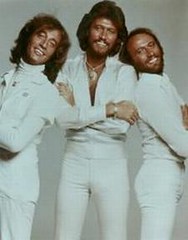
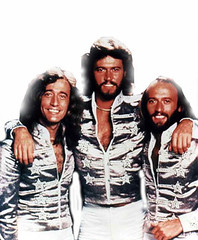

Despite the fact that their 13th single, Spicks And Specks, was bulleting up the local charts, and despite having heard not one word from Epstein, The Bee Gees sailed for England on January 3, 1967.
"We stopped off in India, the Middle East, Cairo, the Pyramids," says Barry. "And the things we discovered in back street bazaars!! You could buy bottles of Dexedrine, every kind of stimulant, no questions asked. We were on a ship, but we flew all the way."
By the time they reached England, Spicks And Specks was Australia's Number 1, but that fact cut little ice in London. "We trudged around Denmark Street," says Maurice, "saw the manager of The Seekers, the manager of Cliff Richard, and they all told us we were wasting our time, groups were out. We were staying in a semi-detached in Hendon wondering what to do when my mother said we'd had a call from Robert Stickweed. We had no idea who that was."
Stickweed was, of course, Robert Stigwood, MD of Brian Epstein's NEMS empire. Impressed by their Beatlish harmonies, he invited them to his office. "He looked very Edwardian," remembers Barry, "with sideburns and a velvet-lapel jacket, Oscar Wilde-ish, with grayer hair. We went into his office, next to The Palladium in Argyll Street, and he gave us 20 pounds each to buy clothes in Carnaby Street."
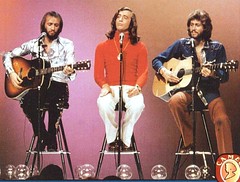

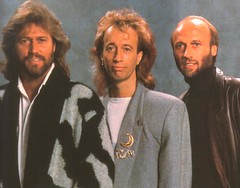
Demonstrating the sartorial élan for which they later became renowned, they returned with capes and buckle-fronted hats. "I was dressed as a priest, with black shroud, sword and tights," admits Barry, "and we got into the lift at NEMS to be confronted by Eric Clapton dressed to the hilt as a cowboy. The lift cranked slowly up to NEMS with these strangely dressed young men inside, eyeing each other up and down, but none of us said a word."
On February 24, they signed a five-year contract with NEMS, on a salary of 25 pounds per week each. Keen to see them perform live, Stigwood secured a support slot a month later at the Epstein-owned Saville Theatre in London, on the opening night of Fats Domino's first UK visit. "We'd formed the band one week earlier with Colin Petersen and Vince Melouney, so we weren't well prepared, but we went on and opened the show. The whole audience was leather-jacketed bikers and teds who only wanted one thing, and that was Fats Domino, as soon as possible please! So missiles started flying and Robin got hit by an egg.

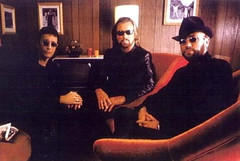
Nevertheless, Record Mirror described them as "an attractive Australian group with an excellent lead singer" and, to the band's delight, Paul McCartney watched from his box and later praised their performance.
Within weeks, thanks to Stigwood's patronage, The Bee Gees were hanging out at The Speakeasy in the company of The Beatles, the Stones, and The Who. "The Speakeasy was a fantastic place, underground with a coffin as the front door and a wall that swung around to let you in," says Barry. "Pete Townshend introduced me to John Lennon, who was sitting there in the full Sgt. Pepper outfit, deep in conversation."Lennon also befriended Maurice, teaching him how to operate The Beatles' mellotron, and lending it for use on The Bee Gees' first album.
"The most significant new talent of 1967", trumpeted the press blurb when Polydor Records released The Bee Gees' UK debut single, New York Mining Disaster 1941, on April 14."It was written at four o'clock one morning, in the Polydor basement, off Oxford Street," says Robin."The basement just made us think of a mineshaft, so we were feeding off our surroundings to create this song about trapped miners."
"The opening chord doesn't sound like a conventional A minor," adds Maurice. "Barry was using the open D tuning he'd been taught when he was nine, and I was playing it in conventional tuning. It gives an unusual blend. People went crazy trying to figure out why they couldn't copy it."
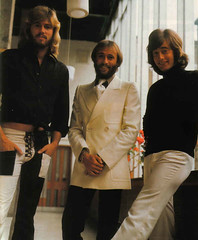
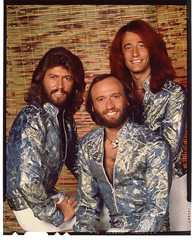

On May 11, with Mining Disaster heading for its peak position of Number 12, The Bee Gees made their first Top Of The Pops appearance, and Maurice met his future wife. "Lulu was doing The Boat That I Row. She was a bit pimply and chubby, but the attraction was instantaneous. It was her personality. It wasn't so much, Oh, I'd love to give her one, I'd just never seen anyone so bubbly and full of life."
New York Mining Disaster repeated its success in America after several stations put it onto heavy rotation a month before release on the assumption that it was actually The Beatles."To be compared with The Beatles was not a problem," notes Maurice."It was an honour, and it broke us in America."
The trio's love affair with Stigwood intensified during recording of their debut LP, with the relationship moving from purely business to a deep friendship. As Robin recalls, "Robert lived at De Walden Court, just off Portland Place, and he would walk to IBC Studio at four in the morning to hear our stuff. Other nights, we'd finish at 3 am, walk to his place and play what we'd done, while he sat in his dressing gown."
The relationship was set to music in the second Bee Gees single, To Love Somebody. "It was written with Otis Redding in mind as the singer," says Barry, "but it was for Robert. I say that unabashedly. He asked me to write a song for him, personally. It was written in New York and played to Otis but, personally, it was for Robert. He meant a great deal to me. I don't think it was a homosexual affection but a tremendous admiration for this man's abilities and gifts."
The various elements that would pull the group apart were in place. Barry notes: "Robin and I were creatively hyper because we were taking speed and things like that. We were young and we wanted to stay up all night so we could write more songs if we were high. On top of that, my closeness to Robert caused trouble because Maurice and Robin felt they were not getting as much of his attention."
Superficially, all looked good. The debut album, Bee Gees First, entered the UK charts on August 12, peaking at Number 8, but all three were living apart for the first time, establishing relationships with women and developing their own circles of friends.Maurice, in particular, was quickly drawn into the heavy-drinking Speakeasy clique.
On Friday, August 25, Robin was visiting secretary Molly Hullis (later to become his wife) in the NEMS office when Brian Epstein arrived in tears and entered Stigwood's office. "He closed the door and there was a lot of shouting. When he came out he was still crying. I said, What's the matter? He said, 'I can't talk.' And he went straight out. Moments later, Stigwood told Robin The Bee Gees would be departing for Monte Carlo that night. "Brian had pleaded with Robert to go to Sussex with him that weekend because he didn't want to be alone," says Robin."The Beatles were in Bangor with the Maharishi. And Robert had said no."
Word reached Stigwood and The Bee Gees in Monte Carlo on Sunday that Epstein had died. "It was awful," remembers Robin. "We had this terrible midnight cruise to Nice so Robert could catch a plane back. He had nothing to do with Brian's death, but he felt tremendously guilty, because if he'd stayed that might not have happened."
Stigwood's emotional turmoil can't have been eased by the knowledge that a deal he'd done with Epstein, giving him the option to buy 51 percent of NEMS, was rendered void by his friend's death. "Brian's brother Clive took over NEMS, and a few weeks later Robert Stigwood Organization offices at 67 Brook Street. The catalyst was Brian's death."


The Bee Gees as they appeared when they sang Massachusetts in a 1967 Christmas show.
The Bee Gees was originally a 5 member band with Barry on rhythm guitar, Maurice on bass,
Vince Melouney on lead guitar and Colin Petersen on drums.
The Bee Gees, naturally, moved out of NEMS with Stigwood, scoring their fist UK Number 1 on October 11 with Massachusetts. Epstein's death was fresh in their minds when 17-year-old Robin unexpectedly had his first brush with the Grim Reaper. "It was Guy Fawkes Night, Massachusetts was in the charts, and I was returning from Hastings with Molly. As the train accelerated through Lewisham, I heard this noise like rocks hitting the side carriage. I said, 'This train's going to crash.'"
Molly said, 'Don't be silly, we always speed up here.' At that moment the lights went out, the train lurched, and a huge chunk of railway line shot up into the carriage right past my face.Two inches more and I'd have been dead. My face was cut, and there were showers of flying glass. The whole carriage flipped onto its side, and there was hissing and screaming."
Forty-nine passengers died in the Hither Green crash, but Robin and Molly dragged themselves up through the shattered window and walked along the top of the side of the train. "We pulled some people out. Molly was bruised and battered. I had glass in my mouth, in my eyes, in my hair, for weeks. It made me realize you could be dead at any minute and you should seize every moment. It wasn't a spiritual experience. I was just very lucky."
www.beegees-world.com/archives13.html
More information behind the Bee Gees
tribute song to Brian Epstein by Eppylover.
mog.com/eppylover/blog/168802

The Bee Gees song "In The Summer of His Years." (3:13 minutes)
[Sorry - The Video Was Removed by User - Not Available]
www.youtube.com/watch?v=gvfDnnv1pX0

The Bee Gees song "Massachusetts." For Maurice Gibb, the song had a painful memory attached. Shortly after
it was recorded, Beatles manager Brian Epstein told him that it was beautiful and would be the hit of the summer.
These proved to be Epstein's last words to Maurice -- Epstein died a few days later. (2:28 minutes)
www.youtube.com/watch?v=DATBz5Gt3B4
